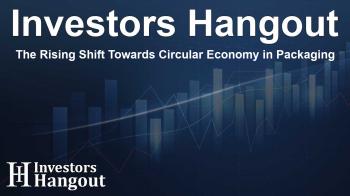The Rising Shift Towards Circular Economy in Packaging

The Rising Shift Towards Circular Economy in Packaging
The concept of a circular economy in packaging is driving significant changes in how products are packaged and consumed. This innovative approach not only emphasizes sustainability but also resource efficiency and waste reduction. With growing environmental concerns and increasing consumer awareness, the global packaging industry is rapidly adopting eco-friendly practices.
Understanding Circular Economy in Packaging
At its core, the circular economy aims to keep materials in circulation as long as possible, thereby minimizing waste. Traditional linear models of packaging—often characterized by a "take, make, dispose" mentality—are gradually being replaced by systems that prioritize reuse, recycling, and composting. This shift challenges manufacturers to rethink packaging designs, pushing them towards materials that can be easily recovered and reused.
Innovation in Materials
One of the key drivers of the circular economy is innovation in packaging materials. Companies are now exploring biodegradable and compostable options that break down naturally, leaving no lasting impact on the environment. For example, packaging solutions derived from agricultural waste or seaweed are gaining popularity as sustainable alternatives to conventional plastics. These materials not only fulfill consumer demand for eco-friendliness but also reflect a commitment to preserving our planet.
Consumer Demand and Brand Commitment
Consumers today are more eco-conscious than ever, often opting for brands that demonstrate environmental responsibility. Surveys indicate that many people are willing to pay a premium for products packaged in sustainable materials, especially in sectors like food and cosmetics. This consumer pressure is prompting brands across the globe to strengthen their sustainability commitments, fostering a culture of circularity.
Current Trends in Circular Packaging
Several trends are shaping the future of circular packaging. One such trend is the rise of reusable and refillable packaging systems. Brands are stepping away from single-use containers and are implementing models that allow consumers to return or refill packages, helping to reduce waste significantly. This approach not only supports environmental sustainability but also offers economic advantages by lowering overall packaging costs.
Technological Advancements
The integration of technology into packaging systems is also notable in the circular economy. Innovations such as smart packaging—with embedded sensors, QR codes, and RFID—enable manufacturers to track and improve the lifecycle of their products. These advancements help ensure that materials are recycled properly and can even provide consumers with information on how to dispose of packaging responsibly.
Government Regulations and Corporate Initiatives
Stringent regulations are further accelerating the shift towards a circular economy in packaging. Governments worldwide are enacting policies that promote recycling and limit single-use plastics, thereby enhancing the market for sustainable packaging solutions. Corporate sustainability initiatives, including commitments from large multinational companies to adopt eco-friendly packaging practices, are also playing a pivotal role in this transition.
Challenges to Overcome
Despite the positive momentum, significant challenges remain in the circular economy for packaging. Issues such as limited recycling infrastructure, material and technology constraints, and the high costs of sustainable materials can hinder progress. Additionally, awareness and education about the importance of recycling systems must be enhanced among consumers to boost participation in circular practices.
Global Perspectives on Circular Packaging
Regions around the world are embracing the circular economy with varying degrees of success. For instance, Europe is leading in terms of regulatory frameworks and public awareness, while Asia-Pacific nations are witnessing rapid growth driven by e-commerce and innovative packaging solutions. This global learning environment encourages countries to adopt best practices and sustainable strategies in the packaging industry.
Frequently Asked Questions
What is the circular economy in packaging?
The circular economy in packaging refers to a sustainable approach that focuses on reusing, recycling, and composting packaging materials to minimize waste.
How do consumer preferences impact circular packaging?
Eco-conscious consumers are increasingly favoring brands that adopt sustainable practices, leading to a demand for packaging that is recyclable or made from sustainable materials.
What are some innovative materials in circular packaging?
Innovative materials include biodegradable plastics, compostable packaging made from agricultural byproducts, and seaweed-based packaging solutions.
What challenges does the circular economy in packaging face?
Challenges include limited recycling infrastructure, material costs, and a general lack of consumer awareness regarding sustainable recycling practices.
How does technology contribute to circular packaging?
Technology plays a role by enhancing tracking and monitoring of packaging materials and integrating smart systems that inform consumers about recycling processes.
About The Author
Contact Lucas Young privately here. Or send an email with ATTN: Lucas Young as the subject to contact@investorshangout.com.
About Investors Hangout
Investors Hangout is a leading online stock forum for financial discussion and learning, offering a wide range of free tools and resources. It draws in traders of all levels, who exchange market knowledge, investigate trading tactics, and keep an eye on industry developments in real time. Featuring financial articles, stock message boards, quotes, charts, company profiles, and live news updates. Through cooperative learning and a wealth of informational resources, it helps users from novices creating their first portfolios to experts honing their techniques. Join Investors Hangout today: https://investorshangout.com/
The content of this article is based on factual, publicly available information and does not represent legal, financial, or investment advice. Investors Hangout does not offer financial advice, and the author is not a licensed financial advisor. Consult a qualified advisor before making any financial or investment decisions based on this article. This article should not be considered advice to purchase, sell, or hold any securities or other investments. If any of the material provided here is inaccurate, please contact us for corrections.

